Fort Richardson State Park and Historic Site - Jacksboro, Texas
Fort Richardson State Park and Historic Site offers a relaxing and enriching all-day visit to a partially restored 19th Century frontier outpost.
By Bob Kerstetter
JACKSBORO, TEXAS—Fort Richardson State Park and Historic Site offers a relaxing and enriching all-day visit to a partially restored 19th Century frontier outpost. For people with additional time, this 450-acre site goes beyond its peep into history by providing modern recreational facilities for camping, hiking, bicycling, horseback riding, picnicking and fishing. Swimming and boating are available nearby at Lake Jacksboro and Lost Creek Reservoir. For all of these activities, visitors supply their own gear, including boats, fishing tackle, swim suits and horses.
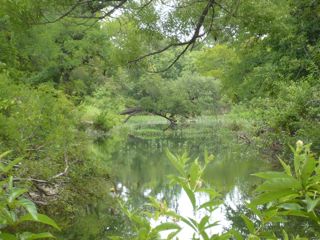 Fort Richardson sits where the North Texas Prairies meet the Panhandle Plains—less than two hours driving time from Dallas, Abilene and Waco and about 60 minutes from Fort Worth and Wichita Falls. Times from Oklahoma City and Austin measure 3.5 and 4.5 hours, respectively. Somewhat muted in its driveway appearance, the serendipity of Fort Richardson begins immediately behind its main gatehouse.
Fort Richardson sits where the North Texas Prairies meet the Panhandle Plains—less than two hours driving time from Dallas, Abilene and Waco and about 60 minutes from Fort Worth and Wichita Falls. Times from Oklahoma City and Austin measure 3.5 and 4.5 hours, respectively. Somewhat muted in its driveway appearance, the serendipity of Fort Richardson begins immediately behind its main gatehouse.
Yankee General Name
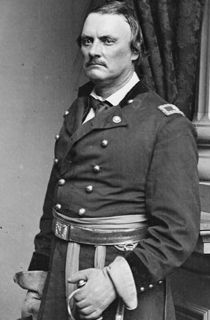 The U.S. Federal Government opened Fort Richardson in November 1867—during the Reconstruction period following the American Civil War—and named it after a popular general from Vermont, a Northern state. While designating a Texas fort in honor of a Yankee general may come across as a bit insensitive toward the recently defeated South, this was likely not the intention. Israel B. Richardson once fought—at least in part—for Texas. Before serving the Union during the War Between the States, Richardson battled well as a leader of men in the Mexican-American War, which—among other things—placed an exclamation point after the Lone Star’s independence from Mexico.
The U.S. Federal Government opened Fort Richardson in November 1867—during the Reconstruction period following the American Civil War—and named it after a popular general from Vermont, a Northern state. While designating a Texas fort in honor of a Yankee general may come across as a bit insensitive toward the recently defeated South, this was likely not the intention. Israel B. Richardson once fought—at least in part—for Texas. Before serving the Union during the War Between the States, Richardson battled well as a leader of men in the Mexican-American War, which—among other things—placed an exclamation point after the Lone Star’s independence from Mexico.
Richardson retired from the military in 1855 to take up farming in Michigan, with its slightly—but not much—longer growing season than his Green Mountain home state. When the bombardment of Fort Sumter initiated Civil War shooting, the West Point graduate re-enlisted. From Spring 1861, Richardson led brigades and divisions into several battles, earning promotions to brigadier general, then major general by Summer 1862. While directing artillery fire on September 17, 1862 during the Battle of Antietam—sometimes called the Battle of Sharpsburg—General Richardson received cannon shrapnel wounds. While the wounds themselves lacked life-threatening severity, they became seriously infected, leading to his death from pneumonia on November 3,1862, two years and five months before the war ended.
Settler Protection
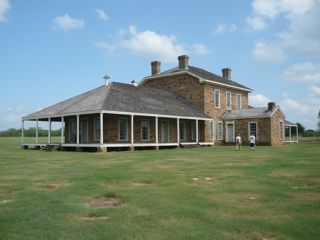 The years following the Civil War became prime times for Indian raiders in northern Texas. Attempting to drive white settlers out of the plains, some Comanches and Kiowas assailed the newcomers. In defense, the United States Army built Fort Richardson, its second effort at fortifying the region. The Army originally built a fort 20 miles further north, but withdrew to the current location because of problems with water supplies, construction materials and constant raids in an unsecured area.
The years following the Civil War became prime times for Indian raiders in northern Texas. Attempting to drive white settlers out of the plains, some Comanches and Kiowas assailed the newcomers. In defense, the United States Army built Fort Richardson, its second effort at fortifying the region. The Army originally built a fort 20 miles further north, but withdrew to the current location because of problems with water supplies, construction materials and constant raids in an unsecured area.
While many settlers and Indians lived peacefully, both sides—including operatives of the Federal Government—frequently took what pleased them, violating the terms of various treaties, including those set during the Medicine Lodge Treaty Council. The government failed to supply reparations, honor the borders of Indian lands and restrict settlements. The Native Americans attacked settlement areas protected by the agreements. Chiefs Satanta and Lone Wolf became infamous for their competing offensives against the settlers. Federal generals, including William Tecumseh Sherman, called for more war rather than peacemaking.
Patrols from Fort Richardson reached north toward Palo Dura Canyon in the Texas Panhandle and the Indian territories of Oklahoma. The Indians attacked patrols from the fort and assaulted caravans of incoming settlers. As part of their tactics, the Army burned Indian villages, killing warriors, women, old men and children. By 1878 the Indians retired from the fight so the Federal Government closed and abandoned Fort Richardson.
Texas purchased Fort Richardson from the City of Jacksboro In 1968 and opened the park.
Summary Tour
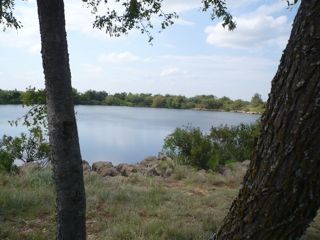 Beyond the main gatehouse of the park sits a mirror-surfaced lake—small, but beautiful. Shade trees over picnic tables offer a sun-guarded retreat. Fishing the Quarry Lake requires no license. The State keeps it stocked all year with catfish and keeper-sized bass. Trout join the year-around stockers from December through February. Though it looks mighty inviting, jumping in for a swim gets visitors warned, expelled or arrested, depending on their attitude about getting caught. Besides, swimming in a quarry lake can be dangerous.
Beyond the main gatehouse of the park sits a mirror-surfaced lake—small, but beautiful. Shade trees over picnic tables offer a sun-guarded retreat. Fishing the Quarry Lake requires no license. The State keeps it stocked all year with catfish and keeper-sized bass. Trout join the year-around stockers from December through February. Though it looks mighty inviting, jumping in for a swim gets visitors warned, expelled or arrested, depending on their attitude about getting caught. Besides, swimming in a quarry lake can be dangerous.
Following Park Road 61, the first left ends at parking for the loop trailhead of the Prickly Pear Trail. Walking the trail to the first junction, a slight left heads toward primitive camping, while veering hard right leads back to PR 61 at the point where it arrives at the fort buildings and parade grounds.
If walking, cross the road. Driving? Pull on into the parking lot. Scamper up to the Interpretive Center and walk in. If the center is closed during normal business hours, a park employee should soon return. If that doesn’t happen, just call the office and someone shows up lickety-split. The parking lot itself supports some trees with interesting trunks.
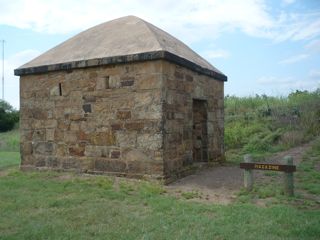 The Interpretive Center tells the story of the fort, soldiers, Comanches and Kiowas, plus the civilian men, women and children who lived in and around Fort Richardson. Bordering the parade ground and extending north, seven buildings in restored condition—except for the tumbled down Guard House—show how people lived. The Officer Quarters supply a glimpse of the good life for the men who brought their families. The Barracks hint at tough times for enlisted troops. The Hospital instills a spirit of wanting to stay healthy—but did provide charcoal-filtered indoor toilet facilities, probably a little disgusting to clean. As for the Morgue—Well, it's a morgue. Extending north, the Bakery is small, the Kitchen missing. The Guard House ruins indicate the smallest people felt the least cramped in the brig. The vents and imploding arched roof of the Magazine control the chaos should the stored gunpowder attract an unwanted spark or flame. One more thing about the Magazine: its totally open doorway and thick stone walls invite visitors into a temperature-controlled space on a hot or cold day. While entering is okay, first step to the threshold and check the floor, including the corners. This is Texas. Rattlers warn before striking, but may wrongly sense a can of worms if trapped between a big person and a wall. No one gets snake bites at Fort Richardson, so avoid becoming the first. Anyway, visitors can easily spend several hours wandering around the buildings and parade grounds. Also, the park offers free guided tours of the old fort facilities.
The Interpretive Center tells the story of the fort, soldiers, Comanches and Kiowas, plus the civilian men, women and children who lived in and around Fort Richardson. Bordering the parade ground and extending north, seven buildings in restored condition—except for the tumbled down Guard House—show how people lived. The Officer Quarters supply a glimpse of the good life for the men who brought their families. The Barracks hint at tough times for enlisted troops. The Hospital instills a spirit of wanting to stay healthy—but did provide charcoal-filtered indoor toilet facilities, probably a little disgusting to clean. As for the Morgue—Well, it's a morgue. Extending north, the Bakery is small, the Kitchen missing. The Guard House ruins indicate the smallest people felt the least cramped in the brig. The vents and imploding arched roof of the Magazine control the chaos should the stored gunpowder attract an unwanted spark or flame. One more thing about the Magazine: its totally open doorway and thick stone walls invite visitors into a temperature-controlled space on a hot or cold day. While entering is okay, first step to the threshold and check the floor, including the corners. This is Texas. Rattlers warn before striking, but may wrongly sense a can of worms if trapped between a big person and a wall. No one gets snake bites at Fort Richardson, so avoid becoming the first. Anyway, visitors can easily spend several hours wandering around the buildings and parade grounds. Also, the park offers free guided tours of the old fort facilities.
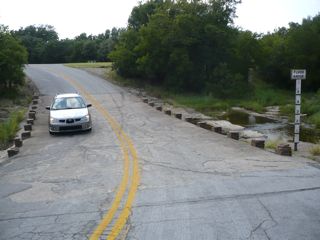 On the road again, the smooth blacktop spirals across a ford, reveals screen shelters, passes picnic areas, and enters the campsites designated for RV and car adventurers. For day-trippers, choose a picnic parking space and take a walk. Lost Creek Nature Trail runs between the ford and campsites 22-23—spanning about .5 miles or .8 kilometers—paralleling the park roadways and generally following the creek. Short paths behind the screen shelters and restrooms provide shortcuts to partway points on the trail. Entering by one of these, hoof it first to the left, then go right, or visa-versa. A nugatory serving of backtracking on a short run causes little pain and generates much enjoyment, at least in this case. Rises and falls in elevation take trekkers in and out of warmer, then cooler environments. The leisurely water supports growth for large trees—some rainbowed into the creek—and bright green vegetation. Filtered light triggers verdant shades too numerous to name or number. Though transparent, even the water sparkles translucently green.
On the road again, the smooth blacktop spirals across a ford, reveals screen shelters, passes picnic areas, and enters the campsites designated for RV and car adventurers. For day-trippers, choose a picnic parking space and take a walk. Lost Creek Nature Trail runs between the ford and campsites 22-23—spanning about .5 miles or .8 kilometers—paralleling the park roadways and generally following the creek. Short paths behind the screen shelters and restrooms provide shortcuts to partway points on the trail. Entering by one of these, hoof it first to the left, then go right, or visa-versa. A nugatory serving of backtracking on a short run causes little pain and generates much enjoyment, at least in this case. Rises and falls in elevation take trekkers in and out of warmer, then cooler environments. The leisurely water supports growth for large trees—some rainbowed into the creek—and bright green vegetation. Filtered light triggers verdant shades too numerous to name or number. Though transparent, even the water sparkles translucently green.
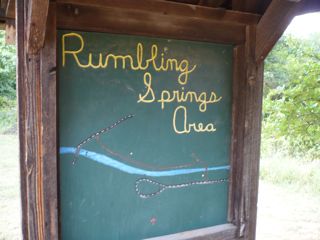 Near the end of Park Road 61, Rumbling Spring Path takes off opposite from site 13, immediately crossing Lost Creek at its narrowest. Large, rough, jagged rocks, plus spiders and—of course—the potential for rattlers and psycho cottonmouths, make closed toe shoes into foot-pleasing amenities. As with the Magazine, fear not. While no one gets snake bit at Fort Richardson, this is no barefoot stroll in soft, cool morning sand. Stroll it is—almost—covering less than 200 yards or 183 meters, on a path with zero level footholds. Take your time. This sort-of-a-stroll is short and could give birth to perfect analogies about haste making waste. Soon, soft bubbling rumblings come within hearing range—delivering memories of tall, cool beverages on smoldering, smothering sticky days. Then into view comes cool, clear liquid sparkling and falling near the base of a natural rock wall, then rumbling over mossy stones to feed the headwaters of Lost Creek. The path continues onward, ending at PK 61 across from the fort buildings and parade ground.
Near the end of Park Road 61, Rumbling Spring Path takes off opposite from site 13, immediately crossing Lost Creek at its narrowest. Large, rough, jagged rocks, plus spiders and—of course—the potential for rattlers and psycho cottonmouths, make closed toe shoes into foot-pleasing amenities. As with the Magazine, fear not. While no one gets snake bit at Fort Richardson, this is no barefoot stroll in soft, cool morning sand. Stroll it is—almost—covering less than 200 yards or 183 meters, on a path with zero level footholds. Take your time. This sort-of-a-stroll is short and could give birth to perfect analogies about haste making waste. Soon, soft bubbling rumblings come within hearing range—delivering memories of tall, cool beverages on smoldering, smothering sticky days. Then into view comes cool, clear liquid sparkling and falling near the base of a natural rock wall, then rumbling over mossy stones to feed the headwaters of Lost Creek. The path continues onward, ending at PK 61 across from the fort buildings and parade ground.
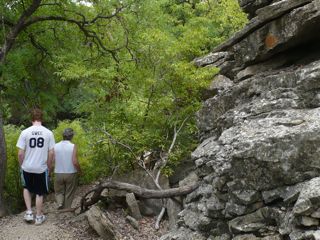 With the exception of several hundred feet between Rumbling Spring and the backside of Park Road 61, the trails at Fort Richardson provide enjoyable pathways for easy strolls. One of intermediate length could take Rumbling Spring Path starting across the road from the Interpretive Center parking lot. After emerging onto PR 61 near site 13, continue on the road to the Lost Creek Nature Trail starting beyond sites 22-23. At the end of this trail, spend some time at the ford before returning up the road to the parking lot.
With the exception of several hundred feet between Rumbling Spring and the backside of Park Road 61, the trails at Fort Richardson provide enjoyable pathways for easy strolls. One of intermediate length could take Rumbling Spring Path starting across the road from the Interpretive Center parking lot. After emerging onto PR 61 near site 13, continue on the road to the Lost Creek Nature Trail starting beyond sites 22-23. At the end of this trail, spend some time at the ford before returning up the road to the parking lot.
For longer walks and hikes, visitors can take the Multi-Use Trail, which begins near campsite 30 and continues nine miles. It roughly parallels Lost Creek until it enters into Lake Jacksboro. From there it follows the shores of Lake Jacksboro and Lost Creek Reservoir, providing for return by reversing the route. The Multi-Use Trail accommodates horses, hikers and mountain bikers, supported by a reasonable set of rules designed to promote fun and courtesy. The park also offers other trials.
Overall, the park is excellent for its history, camping, biking, fishing and hiking. If you like boating and horseback riding, those are available nearby. For both day trips and longer stays, visitor find Fort Richardson State Park and Historic Site at quiet, relaxing place of refuge.
More Information
State Park Guide for Fort Richardson State Park and Historic Site
Find a Destination for Fort Richardson State Park and Historic Site